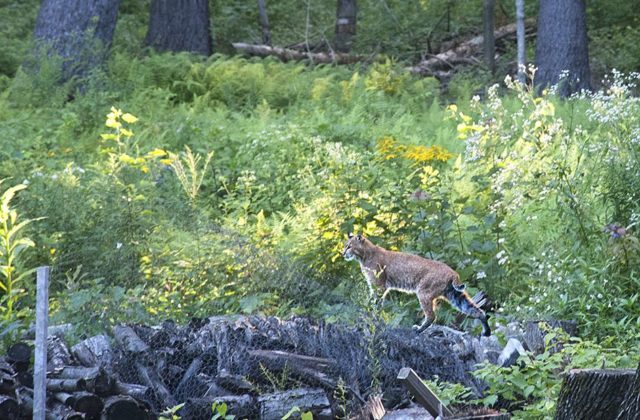State Biologists Call on Public to Report Bobcat Sightings
By Jude Mead
Have you seen a bobcat lately? Have you spotted a footprint of one in the snow? If so, then Jason Hawley, a wildlife biologist with the Department of Energy and Environmental Protection (DEEP), would like to know. Hawley said the state is conducting a bobcat study to evaluate the habitat and range of this common wildcat. “We don’t know that much about the bobcat and by collecting data we can learn how to manage this growing population,” said Hawley.
One way Hawley tracks the bobcat is by trapping them and attaching GPS collars. “We started doing this in September of 2017 and have sampled 50 cats so far. These collars will drop off next fall automatically,” he said. Hawley will then try to get 50 more samples. The information he gathers as part of the Connecticut Bobcat Project will be shared with other states and used to design management strategies.
The other important way Hawley assembles facts for this project is by documenting the bobcat sightings that people report.
“When people see one, or see prints, we ask that they go online or call us to report it. This way we get a good sense of where these cats are located,” he said.
Hawley wants to know the location, the date it was seen, the number seen, and if the cats have been collared or tagged. He suggests that people take pictures of any footprints, setting a quarter next to the print to determine size.
The thickest concentration of bobcats is in the northwest corner of the state. However, these elusive creatures are rarely seen. Hawley said most people never see one. If they do, it is usually crossing the road, where they catch only a glimpse. “This is what makes it a challenge to track them,” he said.
Some people, however, are lucky enough to catch that glimpse. Darla Lovett saw one walking down her driveway. “ I was sitting on my deck having tea when a bobcat came out of the woods. He seemed completely unaware I was there at first, but when he saw me he ran away,” said Lovett.
Most of Lovett’s sightings, though, are on her trail cameras. “My husband and I are wildlife enthusiasts and we set up trail cameras on our property. We captured lots of bobcat pictures,” she said. According to Hawley, trail camera sightings can also be documented with the state.
Gloria Gourley, another Norfolk resident, seems to have the ideal environment for them. It is not uncommon for her to see one trotting across the back yard. “We have plenty of forest, rock ledges and even a stream. Everything to make them happy,” Gourley said.
Hawley said these animals are easy to recognize. “They are mostly brown with faint black spots and usually a white underbelly. They are not very big and can range in size from twenty pounds to thirty-five pounds,” he said. He added that bobcats are distinguished from other wildcats because of their bobbed tail and tufted ears.
Bobcats are also known as fierce hunters who ambush their prey by surprise and pounce on them much like a domestic cat does a mouse. They can take down prey much bigger than their own size. Are they a threat to humans? Hawley says no. “As a solitary creature their instinct is to flee if they sense a person nearby. There are cases where a bobcat may have killed a chicken or a cat, but these are very rare,” he said.
If you see a bobcat contact the DEEP. Observations can be reported in three different ways: send an email to ctwildlife@ct.gov, post sightings on the DEEP Facebook page, Connecticut Fish and Wildlife, or, ideally, record an observation using the free app called iNaturalist.org (search for “CT Bobcat Project” and add your data to it directly).
Photo, top, by Bruce Frisch: This bobcat was stalking for mice behind staff photographer Bruce Frisch’s woodpile last summer.

